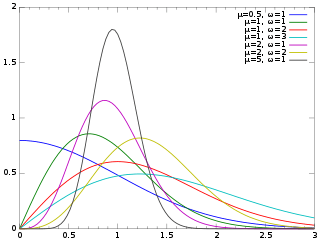Nakagami distribution
The Nakagami distribution or the Nakagami-m distribution is a probability distribution related to the gamma distribution. The family of Nakagami distributions has two parameters: a shape parameter and a second parameter controlling spread .
|
Probability density function  | |||
|
Cumulative distribution function  | |||
| Parameters |
shape (real) spread (real) | ||
|---|---|---|---|
| Support | |||
| CDF | |||
| Mean | |||
| Median | No simple closed form | ||
| Mode | |||
| Variance | |||
Characterization
Its probability density function (pdf) is[1]
where
Its cumulative distribution function is[1]
where P is the incomplete gamma function (regularized).
Parameter estimation
An alternative way of fitting the distribution is to re-parametrize and m as σ = Ω/m and m.[3]
Given independent observations from the Nakagami distribution, the likelihood function is
Its logarithm is
Therefore
These derivatives vanish only when
and the value of m for which the derivative with respect to m vanishes is found by numerical methods including the Newton–Raphson method.
It can be shown that at the critical point a global maximum is attained, so the critical point is the maximum-likelihood estimate of (m,σ). Because of the equivariance of maximum-likelihood estimation, one then obtains the MLE for Ω as well.
Generation
The Nakagami distribution is related to the gamma distribution. In particular, given a random variable , it is possible to obtain a random variable , by setting , , and taking the square root of :
Alternatively, the Nakagami distribution can be generated from the chi distribution with parameter set to and then following it by a scaling transformation of random variables. That is, a Nakagami random variable is generated by a simple scaling transformation on a Chi-distributed random variable as below.
For a Chi-distribution, the degrees of freedom must be an integer, but for Nakagami the can be any real number greater than 1/2. This is the critical difference and accordingly, Nakagami-m is viewed as a generalization of Chi-distribution, similar to a gamma distribution being considered as a generalization of Chi-squared distributions.
Finally, there is also a more efficient generation method using efficient rejection-sampling.[4]
History and applications
The Nakagami distribution is relatively new, being first proposed in 1960.[5] It has been used to model attenuation of wireless signals traversing multiple paths [6] and to study the impact of fading channels on wireless communications.[7]
Related distributions
- Restricting m to the unit interval (q = m; 0 < q < 1) defines the Nakagami-q distribution, also known as Hoyt distribution.[8][9][10]
"The radius around the true mean in a bivariate normal random variable, re-written in polar coordinates (radius and angle), follows a Hoyt distribution. Equivalently, the modulus of a complex normal random variable does."
References
- Laurenson, Dave (1994). "Nakagami Distribution". Indoor Radio Channel Propagation Modelling by Ray Tracing Techniques. Retrieved 2007-08-04.
- R. Kolar, R. Jirik, J. Jan (2004) "Estimator Comparison of the Nakagami-m Parameter and Its Application in Echocardiography", Radioengineering, 13 (1), 8–12
- Mitra, Rangeet; Mishra, Amit Kumar; Choubisa, Tarun (2012). "Maximum Likelihood Estimate of Parameters of Nakagami-m Distribution". International Conference on Communications, Devices and Intelligent Systems (CODIS), 2012: 9–12.
- Luengo, D.; Martino, L. (2012). "Almost rejectionless sampling from Nakagami-m distributions (m≥1)". Electronics Letters (Submitted manuscript). 48 (24): 1559–1561. doi:10.1049/el.2012.3513. hdl:10016/16643.
- Nakagami, M. (1960) "The m-Distribution, a general formula of intensity of rapid fading". In William C. Hoffman, editor, Statistical Methods in Radio Wave Propagation: Proceedings of a Symposium held June 18–20, 1958, pp. 3–36. Pergamon Press., doi:10.1016/B978-0-08-009306-2.50005-4
- Parsons, J. D. (1992) The Mobile Radio Propagation Channel. New York: Wiley.
- Ramon Sanchez-Iborra; Maria-Dolores Cano; Joan Garcia-Haro (2013). Performance evaluation of QoE in VoIP traffic under fading channels. World Congress on Computer and Information Technology (WCCIT). pp. 1–6. doi:10.1109/WCCIT.2013.6618721. ISBN 978-1-4799-0462-4.
- Paris, J.F. (2009). "Nakagami-q (Hoyt) distribution function with applications". Electronics Letters. 45 (4): 210. doi:10.1049/el:20093427.
- "HoytDistribution".
- "NakagamiDistribution".